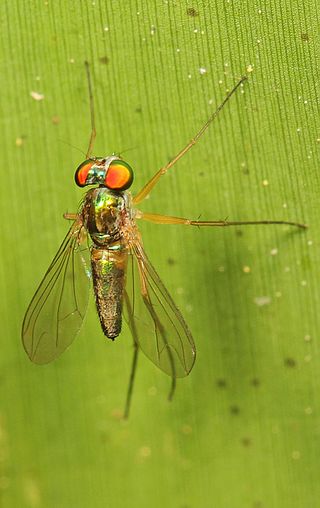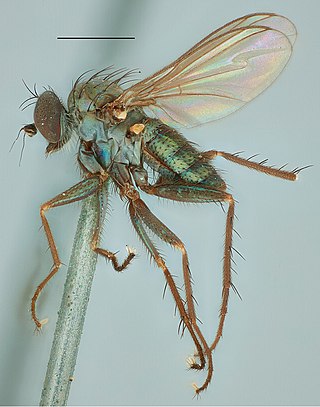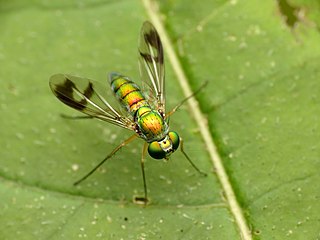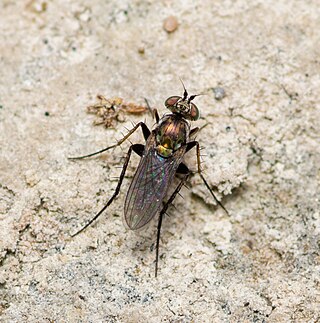
Argyra is a genus of flies in the family Dolichopodidae. The name "Argyra" comes from the Greek word for "silver".

Achradocera is a genus of flies in the family Dolichopodidae. It is distributed in the Nearctic and Neotropical realms as well as in Polynesia. Several Afrotropical species were also placed in the genus, but in 2018 they were transferred to Chrysotus. Achradocera was formerly considered a subgenus of Chrysotus, but was restored as a separate genus by Harold E. Robinson (1975).

Amblypsilopus is a genus of flies in the family Dolichopodidae. It is a large genus, with about 350 species recorded. However, it is possibly polyphyletic.

Asyndetus is a genus of flies in the family Dolichopodidae. There are more than 100 species described for the genus, distributed worldwide.

Condylostylus is a genus of flies in the family Dolichopodidae. It is the second largest genus in the subfamily Sciapodinae, with more 250 species included. It has a high diversity in the Neotropical realm, where 70% of the species occur.

Diaphorus is a genus of flies in the family Dolichopodidae. Lyroneurus is considered by some authors to be a subgenus of this genus.

Medetera is a large genus of flies in the family Dolichopodidae. It includes about 350 species worldwide. The adults are commonly found resting on vertical surfaces such as tree trunks, on which they have a characteristic vertical upright stance. Because of this stance, they are sometimes known as "woodpecker flies". Medetera adults are predators of soft-bodied arthropods, while the larvae are predators of bark beetle larvae.
Mesorhaga is a genus of flies in the family Dolichopodidae.

Paraclius is a genus of flies in the family Dolichopodidae.
Peloropeodes is a genus of flies in the family Dolichopodidae.
Saccopheronta is a genus of flies in the family Dolichopodidae. It is considered a synonym of Medetera by some authors, and a valid genus by others.

Sympycnus is a genus of flies in the family Dolichopodidae.

Syntormon is a genus of flies in the family Dolichopodidae. It includes about 110 species worldwide, more than 50 of which were described from the Palaearctic realm.

Thinophilus is a genus of flies in the family Dolichopodidae. It includes about 146 described species distributed worldwide. Most species of the genus are found in coastal habitats, while a few species are found in freshwater habitats.

Diaphorinae is a subfamily of flies in the family Dolichopodidae.

Gymnopternus is a genus of flies in the family Dolichopodidae. It was formerly placed as a subgenus of Hercostomus, but is now accepted as a separate genus.

Sympycninae is a subfamily of flies in the family Dolichopodidae. In some classifications, this subfamily includes the genera of the subfamilies Peloropeodinae and Xanthochlorinae.












